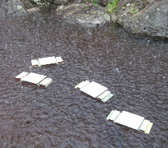27 November 2009
Laughing Waters Artist in Residence Program
 Image: Kate Moore's sound sculptures captured and amplified the sounds of the Laughing Waters property
Image: Kate Moore's sound sculptures captured and amplified the sounds of the Laughing Waters property During her Laughing Waters residency in September-October 2009, Kate Moore designed and built a series of mini sound sculptures that captured and amplified the sounds of the Laughing Waters property. Also featured were works by her colleague, installation artist Kath Fries, who built fragile miniature installations featuring thread spider webs, mirrors and copper spirals.
Being attracted to apply to this residency by its title,
'Laughing waters', stems from a fascination with the relationship
between the audio qualities and emotive aspects of water, music
and the temporal question of time. Much of my work over the past
year has been in pursuit to understand these elements from a
fundamental level, as a means to define my art practice of music
and musical composition. As the greek letter 'Mu' developed from
the phoenician word for water 'mem', and the muses were water
nymphs, it is fitting to parallel the concept and philosophy of
music with the melodic qualities of water.
Coming from this stance, the project that visual artist Kath
Fries and I have embarked on, whilst residing at Laughing Waters
Road, has been productive on a number of levels, primarily in the
development of a method of working together that is directly
related to our surroundings and the subject of water and
time.
The first quality, found at Laughing Waters, is the humble
quietness of the surrounding bushland. Little sounds of various
creatures near and far rhapsodise over the steady percussive
sound of drips in the pond, accompanied by the occasional
counterpoint, provided by blowflies and the distant spectral
cantus firmus of jumbo jets to and from Melbourne. The
sound of the place has so much presence in its quiet harmony that
any additional sound brought in from the 'outside' is by law
required to pay respect and find its own quiet place in the
acoustic landscape.
The house is built of mudbricks, which immediately implies a
balance between the day-to-day activity of people in harmony with
the surrounding flora and fauna, by suggesting that the material
from which it was built is from the earth beneath its floor and
one day it will be returned. Earthy, spartan and rustic, cold in
winter, hot in summer, the house does not hide from the sun, wind
and rain.
From the front studio, surrounded on three sides by walls of
glass, a pond, divided into three and the colour of tea, is as
still as a mirror, providing the home for a metropolis of
invisible frogs, their being made corporeal entirely though their
giant acoustic outcries every night as the sun sets behind the
house over the Yarra River.
As it rains, which it did for the first two weeks, the front
window turns into a giant waterfall.
At every hour of the day, like clockwork, various communities of
wildlife appear as though they banded together to form a roster.
Currawongs, drongos, ants, mosquitos, kookaburras, rosellas,
bunny rabbits...they all came to visit us at the pond at their
appointed time. We even noticed that, as the season changed, the
snakes and spiders came out of their hiding holes. The drongos
made their presence felt, as they had no shame in being curious
about us. For about half a day, they ran around the outside
guttering of the house, peering through the windows to see what
we were up to. One even took it upon himself to fly laps of the
verandah as though training for an olympic event.
At about twelve o'clock every night, another animal made an audio
appearance outside the kitchen window. To this day we don't know
what it was. It sounded like a horse. Maybe it was a kangaroo,
maybe very loud possums, maybe a ghost. Neither of us were game
to find out.
The work that we produced acknowledges the qualities of the
property. Each sculptural piece is like a haiku, pure in form and
essence, balancing the fragile sounds of nature, debris and found
objects with the minutest visual details, such as a tiny rainbow,
a spiderweb, a drip of water. By pointing these out, reflecting
them with mirrors, distilling their essence into a musical
instrument, or imitating them on a large scale, they are
amplified. Tiny details that might otherwise have been missed or
disregarded.
All the pieces blend into the surrounding landscape rather than
imposing themselves upon it. The material used comes from objects
found around the property, such as hose reels, wood, metal
wheels, fenceposts and other items that, like the house, could
return to the ground from whence they came. The sounds, too,
emphasise materials from the property: broken pieces of
porcelain, wire, tiles, nails, pipes, stones, shells, gumnuts, a
whistling teapot, pipes, sticks and the rain. Each little sound
sculpture is to be played by visitors and audience as a means to
engage, like a photo album for the ears, with what we found and
thought beautiful and meaningful.
Further links
Kate Moore - AMC
profile
Laughing Waters Artist in Residence program
© Australian Music Centre (2009) — Permission must be obtained from the AMC if you wish to reproduce this article either online or in print.
Kate Moore lives and works as a composer in the Netherlands and Australia. She has written for ensembles from all over the world including Ensemble Syntonia, Ensemble Klang and The Song Company. Her works have been performed in venues including the National Gallery of Australia, the Museum of Modern Art Massachusetts America, De Ballie in Amsterdam and Theatre des Bouffes du Nord in Paris.
Comments
Be the first to share add your thoughts and opinions in response to this article.
You must login to post a comment.